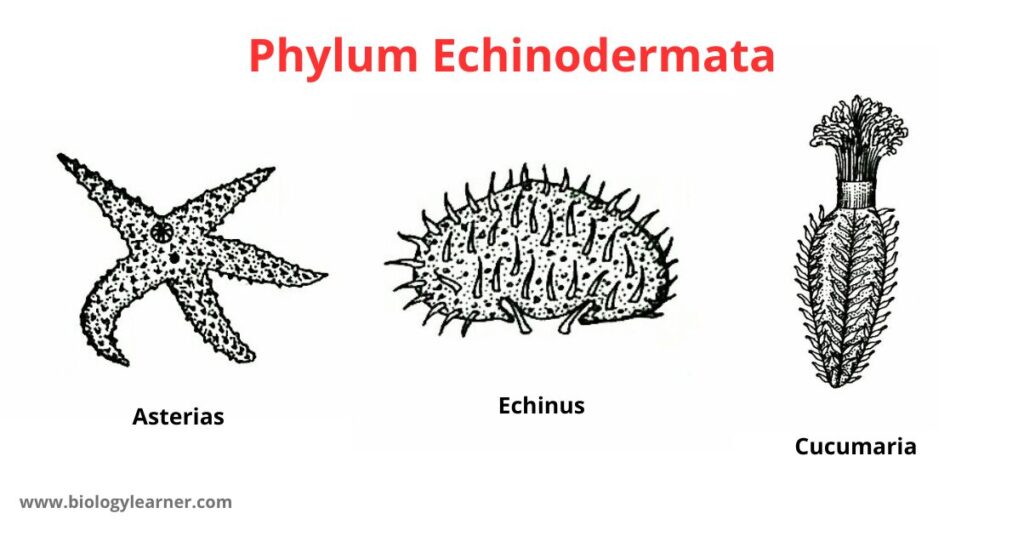Phylum Echinodermata represents the most advanced invertebrate phylum closer to the chordates. They vary substantially in size which may range from 1 cm to about 2 m in length. In 1734 Jacob Klein has coined the name Echinodermata.
The name Echinodermata is derived from the Latin words Echinos and Derma. “Echinos = spine and Derma = skin“
The group of animals in this phylum has spiny skin. The phylum Echinodermata contains more than 7000 described living species. Most of the animals are marine.

Definition of Echinodermata
Phylum Echinodermata is the group of marine invertebrates having radially symmetrical, true coelomate deuterostomus body with a characteristic water vascular system containing calcareous ossicles and spines.
Characteristics of Echinodermata
Some common characteristic features of the phylum Echinodermata are:
- In adult animals, the body is radially symmetrical with pentamerous Organization but the larva has a bilaterally symmetrical body.
- All animals are triploblastic in this phylum.
- Presence of calcareous plates or ossicles as an endoskeleton in the body.
- Ossicles are made of calcium carbonate.
- The body with distinct oral and aboral surfaces.
- The true coelom is present in the body.
- Ambulacral groove is present in most animals.
- Presence of characteristic water vascular system in the body.
- Locomotory organs are tube feet or podia.
- Celia is present on the exterior part of the body.
- The alimentary canal is usually a coiled tube.
- Respiration occurs through papulae or peristomal gills.
- No definite excretory system in the body.
- The nervous system is a diffuse and primitive type.
- The open circulatory system is present. My heart is absent.
- Reproduction is completed in the process of sexual reproduction. Fertilization occurs externally.
- Bipinnaria, Brachiolaria, Ophiopkiteus, Pluteus, and Pentacrinoid larva are present in the life cycle.
- Most of the animals are marine.
Identification Characters
- Body structure: Triploblastic bilaterally symmetrical body.
- Locomotory organs: Tube feet or podia are the laboratory organs.
- Water vascular system: The presence of a characteristic water vascular system in the body.
- Spines and Tentacles: Numerous spines and tentacles are present in the outermost part of the body.
- Body surface: Distinct oral and aboral surfaces are present in the body.
Examples
Some common animals of the phylum Echinodermata are Asterias, Cucumaria, Ophiura, Echinus, Antedon, Clypeaster, Thyone, etc.

Classification of Echinodermata
The classification followed here is based on Hyman’s classification (1955).
The outline of the classification is given below (only living classes and orders):
Subphylum 1. Pelmatozoa
- Class 1. Crinoidea
- Order 1. Articulata (e.g., Antedon)
Subphylum 2. Eleutherozoa
- Class 1. Holothuroidea
- Order 1. Aspidochirota (e.g., Holothuria)
- Order 2. Elasipoda (e.g., Deima)
- Order 3. Dendrochirota (e.g., Cucumaria)
- Order 4. Molpadonia (e.g., Molpadia)
- Order 5. Apoda (e.g., Synapta)
- Class 2. Echinoidea
- Subclass 1. Bothriocidaroida (e.g., Bothriocidaris)
- Subclass 2. Regularia
- Oreder 1. Lepidocentroida (e.g., Palaeodiscus)
- Order 2. Cidaroidea (e.g., Cidaris)
- Order 3. Aulodonta (e.g., Astropyga)
- Order 4. Camarodonta (e.g., Echinus)
- Subclass 3. Irregularia
- Order 1. Clypeastroida (e.g., Clypeaster)
- Order 2. Spatangoida (e.g., Spatangus)
- Class 3. Asteroidea
- Order 1. Phanerozonia (e.g., Pentaceros)
- Order 2. Spinulosa (e.g., Aesretina)
- Order 3. Forcipulata (e.g., Asterias)
- Class 4. Ophiuroidea
- Order 1. Ophiurae (e.g., Ophiothrix)
- Order 2. Euryalae (e.g., Astoporpa)
